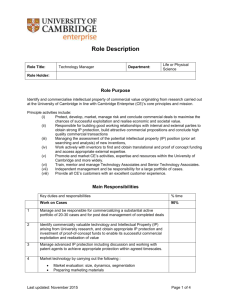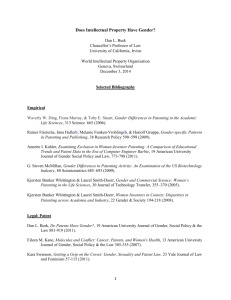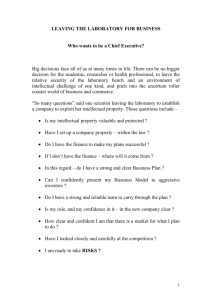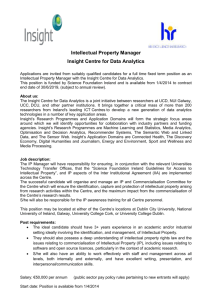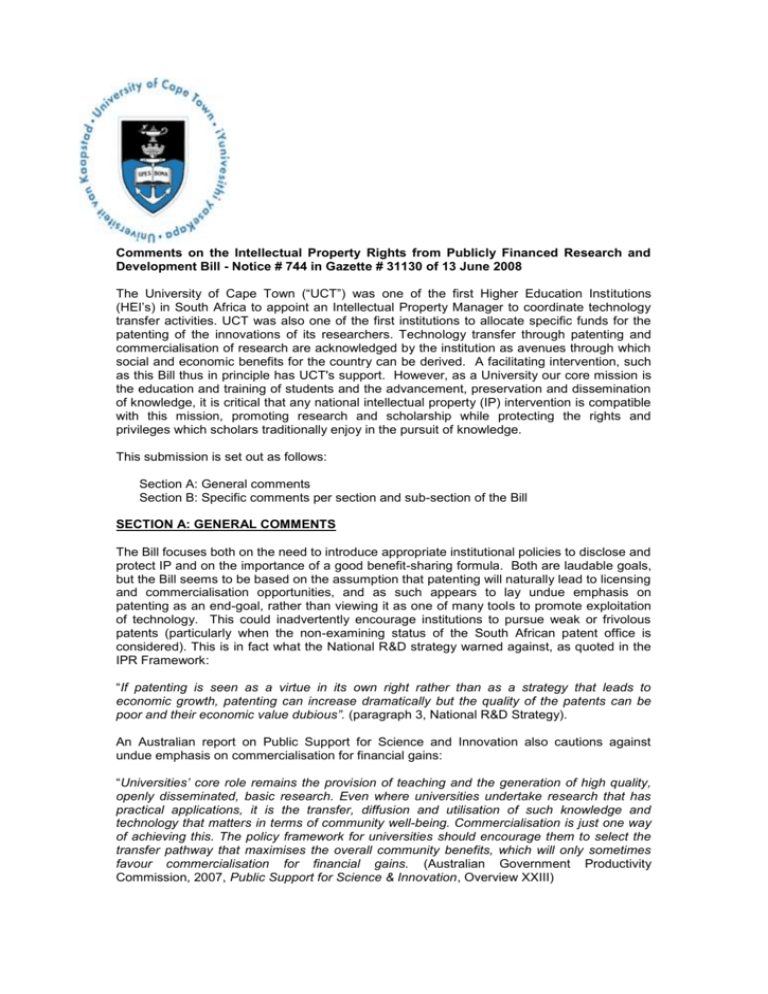
Comments on the Intellectual Property Rights from Publicly Financed Research and
Development Bill - Notice # 744 in Gazette # 31130 of 13 June 2008
The University of Cape Town (“UCT”) was one of the first Higher Education Institutions
(HEI’s) in South Africa to appoint an Intellectual Property Manager to coordinate technology
transfer activities. UCT was also one of the first institutions to allocate specific funds for the
patenting of the innovations of its researchers. Technology transfer through patenting and
commercialisation of research are acknowledged by the institution as avenues through which
social and economic benefits for the country can be derived. A facilitating intervention, such
as this Bill thus in principle has UCT's support. However, as a University our core mission is
the education and training of students and the advancement, preservation and dissemination
of knowledge, it is critical that any national intellectual property (IP) intervention is compatible
with this mission, promoting research and scholarship while protecting the rights and
privileges which scholars traditionally enjoy in the pursuit of knowledge.
This submission is set out as follows:
Section A: General comments
Section B: Specific comments per section and sub-section of the Bill
SECTION A: GENERAL COMMENTS
The Bill focuses both on the need to introduce appropriate institutional policies to disclose and
protect IP and on the importance of a good benefit-sharing formula. Both are laudable goals,
but the Bill seems to be based on the assumption that patenting will naturally lead to licensing
and commercialisation opportunities, and as such appears to lay undue emphasis on
patenting as an end-goal, rather than viewing it as one of many tools to promote exploitation
of technology. This could inadvertently encourage institutions to pursue weak or frivolous
patents (particularly when the non-examining status of the South African patent office is
considered). This is in fact what the National R&D strategy warned against, as quoted in the
IPR Framework:
“If patenting is seen as a virtue in its own right rather than as a strategy that leads to
economic growth, patenting can increase dramatically but the quality of the patents can be
poor and their economic value dubious”. (paragraph 3, National R&D Strategy).
An Australian report on Public Support for Science and Innovation also cautions against
undue emphasis on commercialisation for financial gains:
“Universities’ core role remains the provision of teaching and the generation of high quality,
openly disseminated, basic research. Even where universities undertake research that has
practical applications, it is the transfer, diffusion and utilisation of such knowledge and
technology that matters in terms of community well-being. Commercialisation is just one way
of achieving this. The policy framework for universities should encourage them to select the
transfer pathway that maximises the overall community benefits, which will only sometimes
favour commercialisation for financial gains. (Australian Government Productivity
Commission, 2007, Public Support for Science & Innovation, Overview XXIII)
The Bill imposes demands that are not implementable and is likely to dramatically impact on
the publication output of institutions. The Bill, to a large extent, strips individuals and
institutions of their autonomy to decide on the best route to maximise the social and economic
benefits from the research they perform.
It should be kept in mind that in most cases where countries have opted for Bayh-Dole-type
legislation, the motivation was to address specific national issues (such as employment law
which allowed university inventors to own IP generated in the course of their university
research; or in the case of the US itself, the ownership of IP by the federal government). It is
instructive to take heed of the recommendation of the 2003 UK Lambert Review of BusinessUniversity Collaboration that the UK not adopt Bayh-Dole-type legislation, because of the
different conditions. Similarly, the value of Bayh-Dole–type legislation for Australia is
questioned in the Australian Government Productivity Commission’s report mentioned above.
Therefore, it is imperative that the prevailing circumstances of the South African research
environment are taken into consideration. From a South African perspective it is very
important to note that, whilst institutions in the USA are primarily funded through federal
grants, South African institutions are much more dependent on non-governmental funding to
support their research endeavour. In certain disciplines, such as engineering, a large
proportion of the funding is from industry, locally and abroad. In others, such as Health
Sciences, the major sources of funding are from abroad. Funding programmes such as the
European Commission’s FP7, The National Institute of Health (USA), Wellcome Trust (UK),
and the Swedish International Development Cooperation (SIDA) are not only major sources of
funding, but through collaborative research provide our researchers the opportunity to work
with international experts.
The Bill leaves much concern in regard to funding from non-profit and foreign government
donors. The current requirements of the Bill may result in such entities being discouraged
from providing funding to South African institutions, because the mandatory provisions
contained in the proposed Bill are in conflict with many of these donors’ objectives, namely,
commitments to open access, public use and the like.
The Bill disregards these realities and, in doing so, it also negates the following statement in
the executive summary of the OECD report “Turning Science into Business – Patenting and
Licensing at Public Research Organisations” as incorporated in the IPR Framework:
“While greater compatibility – if not harmonisation – of the policies and practices of PROs
within particular countries has the potential to improve technology transfer by reducing
transaction costs, it can also help induce cross-border harmonisation and thus facilitate
international collaborative research”
A further matter of grave concern is the proposed ‘walk-in’ rights reserved for the State. The
success of Bayh-Dole has been attributed by many, to the US government’s restraint in
exercising its march-in rights. If there is uncertainty in this regard, companies will avoid
licensing IP from public research organisations, or even worse, avoid funding research
completely, because of fears that they will not be able to use the results freely.
Care will have to be taken to ensure that a provision of this kind does not in fact have the
opposite effect of that intended: it must be remembered that Bayh-Dole was introduced
precisely to remedy what was considered an unproductive situation where government owned
the IP concerned. This provision in the Bill would appear to give government stronger rights
than it currently has, and could serve to put South Africa into the position of the US pre-BayhDole era, rather than post-Bayh-Dole era.
Sections 5 and 6 impose specific requirements on institutions to establish and maintain
Institutional Intellectual Property Offices. Besides vague references to incentives, the
corresponding funding to carry out the function is not addressed. If the assumption is that this
intervention will immediately unveil a large amount of commercially viable inventions with
returns for these offices to be profitable within a short space of time, convincing evidence to
support this view is hard to find. In a report by the Australian Centre for Innovation the authors
found that one of the myths, which impedes understanding or effective action on
commercialisation is that ‘universities are a vast untapped source of intellectual property’
(Australian Centre for Innovation, 2002. Best Practice Process for University Research
Commercialisation – Final Report. Commonwealth Department of Education Science &
Training, Australia p. 48). Another study has found that less than 50 per cent of universities in
the USA realise enough royalty revenue to cover the costs of running their technology transfer
office (Tornatzky, L., 2000, Building State Economies by Promoting University-Industry
Technology Transfer, National Governors’ Association. Washington, USA, p. 9).
A Canadian study has found that the quantum of funding required to adequately manage the
commercialisation activities at institutions to be at least 5% of an institution’s total research
budget (Advisory Council on Science and Technology, 1999, Public Investment in University
Research: Reaping the Benefits – Report of the Expert Panel on the Commercialisation of
University Research, Canada, p28). This figure was calculated on the basis of providing two
full time technology commercialisation specialists per 150 faculty members, in addition to
extra funds for IP protection and other "value add" disbursements.
In this regard, The Australian Government Productivity Commission’s report is also worth
noting (page 292):
“As the BIHECC noted: Commercialising research is a complicated and demanding process,
which requires highly skilled staff with strong commercial backgrounds. Skilled commercial
managers are highly sought after internationally and are expensive to both attract and keep.
Unless sufficiently resourced, university knowledge transfer and commercialisation offices will
struggle to employ the calibre of staff required to deliver on the commercial potential of their
portfolios. (sub. 55, p. 12)
Moreover, it seems unlikely that such dedicated units can be self-sustaining for all but the
large research-intensive universities. In 2003, across all universities, income from royalties,
trademarks and licences was only $34.9 million or 0.3 per cent of total university income
(Howard Partners 2005b, p. 17). In this regard, it is worth noting that while UniQuest Pty
Limited has now grown and developed to the point where it is self financing, this has taken 10
years and required a significant investment of cash and resources by the University of
Queensland. This is not surprising, since to be self-sustaining, commercialisation units would
require an ongoing throughput of commercialisable IP. While universities are repositories of a
great deal of knowledge, commercialisable IP is a rarer asset, shaped as it is by market
opportunities and user preferences.”
In its current form this proposed legislation will be at the expense of institutions’ mandate to
deliver on their teaching, research and community service mandates. Direct subsidisation of
the State to the institutions must be built into this Bill.
In summary, the principle of a guiding framework is not contested. However, the Bill ignores
the reality of our current funding structures, international treaties and cooperation
arrangements, the basic mission of HEI’s, namely the promotion of research and scholarship,
while protecting the rights and privileges which scholars traditionally enjoy in the pursuit of
knowledge. Furthermore, the Bill has financial implications that will be to the detriment of
institutions to deliver on their teaching, research and community service mandates. In our
view the intent of the Bill is sound, but the implementation will not realise these intentions.
SECTION B: SPECIFIC COMMENTS PER SECTION AND SUB-SECTION OF THE BILL
1. Definitions
‘Commercialisation’: This definition considers ‘benefit to the society’ as a commercial
outcome. However the rest of the Bill seems to consider financial/monetary returns as the
indicator of commercialisation success.
Queensland Public Sector Intellectual Property Guidelines (Version 2, Jan 2007) describe
commercialisation as follows:
“ in the government context …….., commercialisation means:
- The dissemination of public sector IP to fulfill a government objective;
- The promotion of knowledge transfer (this can be provided free of charge or for a fee);
and/or
- The transfer of IP from the agency to the marketplace for a commercial return.
The commercialisation of IP can occur in a variety of ways, including:
- Free distribution/service delivery;
- Cost of provision (under IS33 Principles)#;
- Exchange of IP;
- Provision of expert advice;
- Sale or assignment;
- Licensing;
- Collaborative ventures/strategic alliances;
- Direct government commercialisation; and
- Spin-off companies.
# Information Access Policy: Purpose: The Information Access and Pricing Policy was
developed to assist agencies to manage this resource to better achieve
the Government’s social and economic objectives.”
‘Intellectual Property’ The definition of intellectual property currently in the Bill has a real
likelihood of negative consequences. The definition refers to creations 'capable of being
protected by law from use by any other person, whether in terms of South African law or
foreign law. This creates an impossible situation as it over-broad, since it refers not only to
intellectual property rights but to any law which prevents use, which could include competition
laws, both common law and statutory competition law, defamation law, labour law, privacy
laws and the like. It is impossible to know all the ways in which a person might be prevented
from using a creation of the mind, it is even impossible to know precisely whether an
intellectual creation would be subject to intellectual property in all the jurisdictions of the
world. Since a court could not reasonably discover all the possible permutations of intellectual
property law in all the world the provision is void for vagueness. In addition patent rights are
territorial, and section 12 restricts transactions which would licence intellectual property
offshore. This creates a situation where a recipient may be obliged to obtain rights in another
jurisdiction but simultaneously discouraged from doing so.
The current definition has the further unfortunate consequences. The requirement that
statutory protection, which seems to refer to registered rights coupled with a definition of
protection anywhere in the world, must be obtained, requires Universities and Research
Councils to obtain software patents. Software patents are available in the United States as
the result of a judicial decision which has never been confirmed by the US Supreme Court.
However South African patent law does not permit software patents, and the Minister of
Public Administration has condemned opportunistic software patents as abusive. The Bill
requires that software be commercially exploited, by means of proprietary licences. This is
directly contrary to the open source policy adopted by government, and defeats one of the
primary purposes of that policy which is the encouragement of software skills development
which will be able to serve the information technology needs of government.
‘Publicly Financed Research and Development’ - This definition is unclear. The NRF for
example has various funding schemes which inter alia support bursaries, running costs,
international travel and conferences, equipment, sabbatical, and workshop/ seminar costs.
Some of these funding schemes are subjected to bilateral agreements between the funding
body and the institution – an issue that is not addressed in this Bill at all. The question could
also be asked whether the bursaries funded through these various schemes will still qualify as
bursaries under the Income Tax Act. It is also unclear whether and under what conditions
funds from other Publicly Funded Institutions (which may or may not have originated from
Government) would be included. If they are included, which institution would own the IP?
Cognisance should be taken of the Bayh-Dole Act in this regard. It specifically excludes
federal grants that are primarily for the training of students and postdoctoral scientists. “.. no
scholarships fellowship, training grant, or other funding by a Federal agency for educational
purposes will contain any provision giving the Federal Agency any rights to inventions made
by the awardee”
Section 2 : Objects of Act
It is recommended that the Act should have the following objects:
To make provision that knowledge from publicly financed research is utilised for the benefit of
society, whether it be for social, economic, military or other purposes;
To require recipients of publicly financed research to assess, record and report on the benefit
for society of publicly financed research;
To acknowledge and reward human ingenuity and creativity;
To protect intellectual property developed from publicly financed research from appropriation,
and ensure that it is available to the people of the Republic;
To require the identification of commercialisation opportunities of intellectual property from
publicly financed research;
To enable the State, where necessary, to use the results of publicly financed research and
development and the attendant intellectual property in the interests of the people of the
Republic.
s2(2)c. Publications are not defined in the Bill and could be interpreted very broadly. It could
include journal articles, notes, conference papers, books, monographs and possibly also all
course notes, web pages, weblogs, MSc and PhD theses, and publicity material, depending
on the interpretation. This implies a researcher will have to enter into and/or require
collaborators to enter confidentiality agreements every time they exchange information.
Section 4: Choice in respect of Intellectual Property
The effect of this section is that if an institution decides not to file a patent for an invention, the
institution and the relevant inventors will lose all control of their research output until NIPMO
makes a decision; thereby removing autonomy from researchers and institutions. Section 4(3)
mentioned a ‘prescribed period’ (not defined) a timeline in which NIMPO must act, however
there is nothing in the Bill which sets out the consequences of a failure to act.
This could potentially be seen as a limitation of the right of academic freedom set out in
section 16(1) (b) and (d) of the Constitution. Apart from the issue of control, the issue of the
practicality of implementing this sub-section needs to be considered. It seems highly unlikely
that there will be the resources available at either the Institutional level or the NIMPO level to
manage and make timely decisions.
This section is not practical and might have a dramatic impact on the publication outputs of
institutions. All indications are that publications will be delayed for extensive periods
By implication an institution/inventor will have no rights to the IP once NIPMO has decided to
take ownership. Provision should be made for institutions/inventors to retain a non - exclusive
royalty-free license to use the IP for research, teaching and publication purposes.
Most International journals require assignation of copyright. This legislation makes it almost
impossible to publish in international journals.
Sections 5, 6 & 7
Statutory requirements are being imposed without corresponding funding to carry out the
function. Institutions cannot be expected to find funding from already stretched budgets for IP
management and commercialization, and these activities should not be at the expense of the
primary mandates of HEIs, i.e. teaching, research and community service. In addition, the
generation of income from commercialization is very unlikely to be sufficient to make these
offices self-sufficient and profitable, even in the long term, as evidenced by studies
elsewhere. In the USA up to 50% of TTOs are still operating at a nett loss. Direct
subsidization of the Institutions by the State must therefore be built into the Bill.
To quote form the executive summary of OECD report “Turning Science into Business –
Patenting and Licensing at Public Research Organisations”:
“Much of the focus of the reform to legal frameworks has been on the issue of transferring
ownership of IP to the performing institution. However, in several countries where PROs have
owned the IP, patenting activity by institutions has nevertheless been weak. Part of the
reason is that PROs have not had sufficient incentives, beyond legal requirements or
institutional policies, to disclose , protect and actively commercialise IP”
“In many OECD countries, non-IP related laws and regulations such as public-sector pay
scales that make it difficult for PROs to recruit qualified technology transfer personnel can be
a barrier to capacity building in technology transfer”
These sections refer to statutory protection, which is not defined but is apparently a reference
to the species of intellectual property rights which require registration such as patent rights.
All intellectual property rights are granted by statute, including copyright, and performers
protection both of which do not require registration, but arise ex lege when certain conditions
are met. Copyright arises when a qualified person reduces an original work, of a specified
kind, to material form. It would therefore be preferable to refer to obtaining registered rights
rather than statutory rights.
When a researcher identifies intellectual property rights arising from research as potentially
commercially valuable, then the researcher should report that potential as set out in section 5
(2). Where a researcher identifies intellectual property rights arising from research as
requiring registered rights then the researcher should report that potential as set out in section
5(2). Intellectual property arising from publicly financed research might require obtaining
registered rights as appropriate protection. This does not mean that those rights should
necessarily be commercially exploited but instead may play a role in preventing appropriation
by defensive registration, participation in a patent pool or other means of preventing
appropriation.
Thereafter that specifically identified research should not be publicly disclosed in a way which
would prejudice obtaining registered rights in the research. The identification of potentially
commercially valuable intellectual property should be dealt with according to guidelines which
enable the identification of that research, and appropriate ways of avoiding premature
disclosure of that research. However research in respect of which no such requirement has
been identified should not be subject to the same restrictions and researchers should be
entitled to publish it. The requirement that recipients should assess all publicly financed
research for intellectual property which may be prejudiced by publication seems to require
technology transfer offices to examine all research prior to publication. Technology transfer
offices do not have the capacity to process all research carried out in an research institution,
nor is it desirable that they should do so, since it each case it requires an understanding of
highly specialised, extremely complex scientific knowledge, instead researchers should be
required to identify when it seems likely that research results shall require registered rights.
Recipient's shall report on all the types of protection used, and the rationale for using them.
Recommendation:
Researchers should therefore have the responsibility of alerting recipients on appropriate
protection for research.
Research institutions should introduce codes of good practise to guide research workers in
applying appropriate protection to research, and identifying research likely to be commercially
valuable.
Draft Provisions:
Additional Recipient obligations
Addition to current s5(1)
(f) in the case of an institution to put in place mechanisms to annually assess, record and
report on the benefit for society of publicly financed research conducted in that institution to
the Department of Science and Technology;
Addition to current s5 (2)
provide effective and practical measures and procedures for the protection of intellectual
property;
amend current s5 (2) (b) to read
ensure that personnel involved in research and development disclose to the recipient that
research results might require registered rights protection or are potentially commercially
valuable, prior to the publication of that research
amend current s5 (2) (c)
assess intellectual property identified by researchers as requiring registered rights, or having
potential for commercialisation, to determine whether it merits registered rights, and where
appropriate apply for and ensure that it obtains registered rights in its name
amend current s5 (2) (d)
refer disclosures for which it elects not to obtain registered rights to NIPMO within 30 days of
making such election;
amend current s5 (2) (e)
report on intellectual property for which it elects to obtain registered rights, the reasons for
obtaining protection, and where appropriate, the state of commercialisation of the rights to
NIPMO on a biannual basis
delete current s5 (2) (f) and (g)
Additional definition:
protection means applying an open licence, including in an open source project, obtaining
registered rights and using registered rights for commercial, defensive, or to provide an open
patent or design licence in the public interest, whichever is appropriate for the research
results;
registered rights means patent, design or other intellectual property rights requiring
registration to exit
Section 10: Rights of intellectual property creators in institutions to benefit sharing
S10(1) The provision requiring that creators are only entitled to revenue from intellectual
property if they are South African citizens or ordinarily resident in the Republic will discourage
foreign doctoral and post-doctoral students from carrying out research in South Africa, since
while they might arguably benefit during their residence in the Republic they will cease to
benefit when the leave South Africa. They may not be entitled to stay in South Africa. Many
foreign doctoral and especially post-doctoral students bring external funding, skills and
experience to contribute to research in South Africa. Gifted South African researchers with
external funding will have an incentive to conduct research outside the Republic. South Africa
will lose the inventors by trying to retain all the revenue from the invention. This provision will
deter most scientists and developers from participating in research or development in South
Africa, to the detriment of the stated principles of the bill
S10(2). This conflict with Institutions’ policies regarding benefit sharing. The norm is to base
this on nett revenue and not gross. The definition of revenue includes ‘non-monetary’
benefits. How will this be considered and manage in the calculation of the 20%?
Section 11: conditions for intellectual property transactions
11 (1). All these conditions leave little opportunity for the recipient to negotiate the best
possible deal and operate independently. NIMPO’s right to interfere will scare off potential
licensees
11 (1) (d & f). Under (d) the word ‘feasible’ is used, but (f) seems to be much stricter on the
same matter.
Section 12: Restrictions on offshore intellectual property transactions
There are already regulations in this regard (exchange control regulations), which require
approval from the Reserve Bank for foreign transactions). This will lead to over-regulation and
will have a negative effect on foreign transactions.
Sixty percent of the universities research income and a third of all research contracts are with
foreign entities –all of which have IP clauses. Does this mean that we will have to advise
NIPMO on all of these contracts?
Section 13: Intellectual Property Fund
3 (c).This means that any assignment (whenever and even if it is assigned to a South African
entity other than an institution), even if it is the best way to commercialise, will require of
the institution to refund the IP Fund all patent expenditure. Not a practical arrangement.
Section 14: Acquisition of intellectual property rights by the state.
The way in which ‘commercialisation’ is used in this section suggests it refers on to financial
returns and does not consider the broader definition of commercialisation.
Section 15: Co-operation between private entities or organisations and institutions
As discussed under Section A above, various aspects of this section
negatively impact on international collaboration and funding
may potentially





